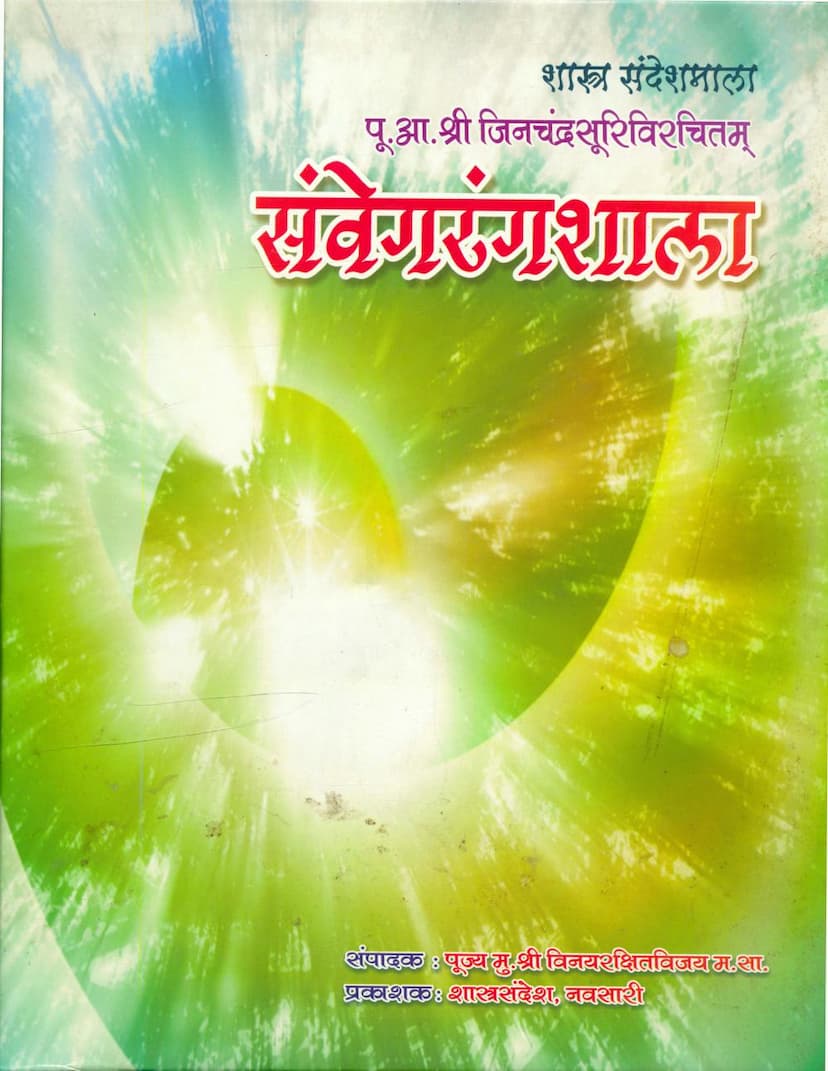Samveg Rangshala
Added to library: September 2, 2025

Summary
Certainly! Here's a comprehensive summary of the Jain text "Samveg Rangshala" based on the provided catalog link and page snippets.
Book Title: Samveg Rangshala Author: Acharya Bhagwant Shri Jinachandrasurishwarji (as original author) Editor/Compiler: Muni Shri Vinayrakshitvijayji Publisher: Shastra Sandesh, Navsari
Catalog Link: https://jainqq.org/explore/022285/1
Overall Summary:
"Samveg Rangshala," authored by the venerable Acharya Jinachandrasurishwarji and compiled/edited by Muni Vinayrakshitvijayji, is a significant Jain text that delves deeply into the path of spiritual practice and detachment. The title itself, "Samveg Rangshala," can be interpreted as a "pavilion" or "theater" of "Samveg," which in Jain philosophy refers to a profound sense of renunciation, detachment from worldly affairs, and a yearning for liberation (Moksha).
The book aims to guide individuals, particularly householders, towards understanding and practicing the principles of Jainism, emphasizing the importance of spiritual conduct, especially during the crucial final stages of life or in the pursuit of liberation.
Key Themes and Content:
-
Origin and Context: The text is based on a request made to Acharya Jinachandrasurishwarji by his elder Gurubandhu, Acharya Abhaydevsurishwarji, to compose a work on this subject. The text was originally composed in Vikram Samvat 1125 (approximately 1068 AD) and was later refined, augmented, and compiled by Gani Shri Gunachandragani (disciple of Acharya Devbhadrasuri, disciple of Acharya Prasannachandrasuri). Research indicates that the core subject matter may be derived from ancient Jain texts, specifically addressing the profound question posed by Mahasen Rajarishi to Shri Gautam Swami after attaining Kevala Gyan: "When the body is no longer useful for intense penance, how should the final practice be performed?" The book includes the elaborate answer provided by the Keval Jani Gautam Swami.
-
Core Concept of Samveg: The fundamental theme of the book is 'Samveg,' which is defined as a deep-seated fear of the cycle of birth and death (samsara) and a strong desire for liberation (Moksha). The author meticulously outlines the stages of spiritual practice for cultivating and maintaining this 'Samveg' after its attainment.
-
Structure and Methodology: The text is structured around four main sections (Dwaras) and further divided into 43 sub-sections (Petta Dwaras). These sections detail the step-by-step process of spiritual discipline and self-purification. The four main sections are:
- Parikarma Vidhi (Preparation Ritual): This section likely covers preparatory steps for spiritual practice, including ethical conduct, purification, and the mindset required. It has 15 sub-sections covering topics like Arihanta, Linga, Shiksha, Vinay, Samadhi, control of the mind, conduct regarding rulers, results of actions, renunciation, contemplation of death, etc.
- Pargana Sankraman (Transfer of Spiritual Elements): This section, with 10 sub-sections, might deal with the process of spiritual progression, direction, atonement, guidance, introspection, and examination of one's spiritual state.
- Mamattva Ucchhed (Eradication of Attachment/Possessiveness): This section, comprising nine sub-sections, focuses on the detachment from worldly possessions and self-identity. It includes topics like confession, renunciation of sleep, possessions, guru's commands, observation, loss, breaking attachments, forgiveness, and enduring hardship. The first sub-section, 'Alochna Vidhan,' itself has 10 further subdivisions on when, whom, how, and the merits/demerits of confession.
- Samadhi Labh (Attainment of Equanimity/Peace): This section, with 9 sub-sections, describes the path to spiritual peace and equanimity. It covers topics like guidance, sustenance, recollection, armor (protection), equanimity, meditation, Lishya (state of mind), fruits of practice, and transcendence. The first sub-section, 'Anushasti Dwar,' has 18 sub-sections covering various spiritual disciplines and virtues.
-
Content Examples: The text elaborates on various aspects of spiritual discipline with illustrative examples. It traces the lineage of spiritual guides and concludes with the life and teachings of Mahasen Rajarishi, his renunciation, Indra's praise, obstacles faced, and the description of his future lives.
-
Historical Significance and Reproduction: The current edition of "Samveg Rangshala" is a re-publication based on a manuscript written in Vikram Samvat 1203 (approximately 1146 AD). The previous edition was published in Vikram Samvat 2025 (around 1968 AD), compiled by Muni Hemandravijayji and Pandit Babubhai Savchand Shah, based on a manuscript from VS 1203. This previous edition is now scarce and unavailable. Recognizing the importance of preserving this extensive Prakrit text, which comprises ten thousand verses, Shastra Sandesh has undertaken its re-publication, including the creation of an index for easier access. The text has been reviewed and corrected for accuracy by Muni Bhadragnashriji and Pandit Ratilal Chimanalal Doshi.
-
Method of Funding: The publication of this book was made possible through the revenue generated from a religious discourse (Upaj) during the initiation (Diksha) ceremony of Jitu Bhai Shantilal Shah in Kandivali-Iranwadi Sangh, held under the spiritual guidance of Gani Nyaibhadravijayji and others.
Purpose and Significance:
"Samveg Rangshala" serves as a spiritual guide, aiming to help readers achieve 'Samveg,' cultivate detachment, and progress on the path to liberation. It provides detailed instructions and philosophical insights derived from Jain scriptures, making it a valuable resource for spiritual seekers. The text underscores the meticulous and systematic approach required in Jain spiritual discipline, emphasizing the purification of mind, speech, and body.
In essence, "Samveg Rangshala" is a profound work that offers a comprehensive roadmap for spiritual discipline, emphasizing detachment, ethical living, and the ultimate goal of Moksha, as taught within the Jain tradition.